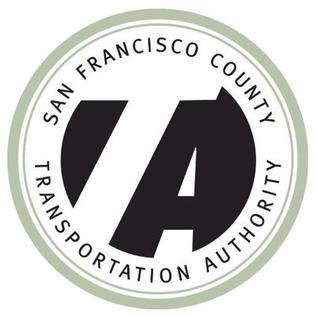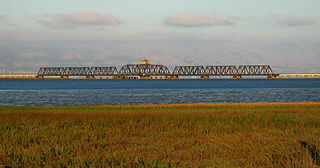The Alameda County Transportation Commission (abbreviated as ACTC or as Alameda CTC) is a government agency responsible for planning of county-wide transportation efforts, allocating of funding to street, highway, bicycle, pedestrian, and transit programs, and management of select construction projects across Alameda County, California.
Alameda CTC is a joint powers authority and a congestion management agency.
Current planning initiatives include redesigning surface arterial roads that run the length of the county such as San Pablo Avenue and East 14th Street. [1]
Alameda CTC is responsible for administering and distributing funds from a voter-approved sales tax (Measure BB, 2014) [2] . Other local sources of funds administered by the commission include a voter-approved vehicle registration fee (Measure F, 2010). [3]
The commission is also responsible for helping to allocate and distribute regional, state, and federal transportation funds in collaboration with the Bay Area-wide Metropolitan Transportation Commission. [4]
Alameda CTC also funds and operates the Alameda County Safe Routes to School program.
Current capitol projects constructed and managed by Alameda CTC include high-occupancy toll lanes along I-680 and I-580. [5]
Alameda CTC uses Measure BB sales tax funds to augment and extend funding for the operation of transit service in the county. Transit service operators utilizing these funds include AC Transit, Altamont Corridor Express, BART, WHEELS, WETA, Union City Transit, and the proposed Valley Link. [6]

The Dumbarton Bridge is the southernmost of the highway bridges across San Francisco Bay in California. Carrying over 70,000 vehicles and about 118 pedestrian and bicycle crossings daily, it is the shortest bridge across San Francisco Bay at 1.63 miles. Its eastern end is in Fremont, near Newark in the San Francisco Bay National Wildlife Refuge, and its western end is in Menlo Park. Bridging State Route 84 across the bay, it has three lanes each way and a separated bike/pedestrian lane along its south side. Like the San Mateo Bridge to the north, power lines parallel the bridge.

AC Transit is an Oakland-based public transit agency serving the western portions of Alameda and Contra Costa counties in the East Bay of the San Francisco Bay Area. AC Transit also operates "Transbay" routes across San Francisco Bay to San Francisco and selected areas in San Mateo and Santa Clara counties. AC Transit is constituted as a special district under California law. It is governed by seven elected members. It is not a part of or under the control of Alameda or Contra Costa counties or any local jurisdictions.

The Santa Clara Valley Transportation Authority, more commonly known simply as the Valley Transportation Authority (VTA), is a special district responsible for public transit services, congestion management, specific highway improvement projects, and countywide transportation planning for Santa Clara County, California. It serves San Jose, California, and the surrounding Silicon Valley. It is one of the governing parties for the Caltrain commuter rail line that serves the county. In 2023, the VTA's public transportation services had a combined ridership of 26,610,000, or about 87,100 per weekday as of the first quarter of 2024.

The Altamont Corridor Express is a commuter rail service in California, connecting Stockton and San Jose during peak hours only. ACE is named for the Altamont Pass, through which it runs. Service is managed by the San Joaquin Regional Rail Commission, and operations are contracted to Herzog Transit Services. The 86-mile (138 km) route includes ten stops, with travel time about 2 hours and 12 minutes end-to-end. In 2023, the line had a ridership of 576,300, or about 2,700 per weekday as of the first quarter of 2024. ACE uses Bombardier BiLevel Coaches, MPI F40PH-3C locomotives, and Siemens Charger locomotives.

The Benicia–Martinez Bridge refers to three parallel bridges which cross the Carquinez Strait just west of Suisun Bay in California; the spans link Benicia on the north side with Martinez on the south.

Golden Gate Transit (GGT) is a public transportation system serving the North Bay region of the San Francisco Bay Area in California, United States. It primarily serves Marin County, Sonoma County, and San Francisco, and also provides limited service to Contra Costa County. In 2023, Golden Gate Transit had a ridership of 1,366,600, or about 4,400 per weekday as of the first quarter of 2024.

The San Francisco Municipal Transportation Agency is an agency created by consolidation of the San Francisco Municipal Railway (Muni), the Department of Parking and Traffic (DPT), and the Taxicab Commission. The agency oversees public transport, taxis, bicycle infrastructure, pedestrian infrastructure, and paratransit for the City and County of San Francisco.

The government of the City and County of San Francisco utilizes the "strong mayor" form of mayoral/council government, composed of the Mayor, Board of Supervisors, several elected officers, and numerous other entities. It is the only consolidated city-county in California, and one of only thirteen charter counties of California. The fiscal year 2019–20 city and county budget was approximately $12.3 billion.
The Bay Area Toll Authority (BATA) is a state agency created by the California State Legislature in 1997 to administer the auto tolls on the San Francisco Bay Area's seven state-owned toll bridges. On January 1, 1998, the Metropolitan Transportation Commission (MTC) — the transportation planning, financing and coordinating agency for the nine-county region — began operations as BATA. In August 2005, the California Legislature expanded BATA's responsibilities to include administration of all toll revenue and joint oversight of the toll bridge construction program with Caltrans and the California Transportation Commission.

The Transportation and Land Use Coalition (TALC) is a non-profit organization which serves as a partnership of over 100 organizations in the San Francisco Bay Area focused on smart growth, public transportation, environmental causes, and other issues connected with transit and urban planning. TALC was founded in 1997, and is based in Oakland, California. A year after its founding, TALC's involvement in public-transportation advocacy was cited as part of a shift toward public support for increasing funding for buses, trains, and bike paths.
Throughout the history of Bay Area Rapid Transit, there have been plans to extend service to other areas.

The San Francisco County Transportation Authority (SFCTA) is a state chartered sub-regional transportation planning and programming agency for San Francisco County. SFCTA is a separate legal entity from the San Francisco Municipal Transportation Agency, the Metropolitan Transportation Commission, and other transportation agencies in the San Francisco area, with its own administrative structure, policies, staff, budget, and with separate borrowing capacity. The Authority Board consists of the eleven members of the San Francisco Board of Supervisors.

Bike East Bay, formerly known as East Bay Bicycle Coalition, is a Californian non-profit organization that worked since 1972 toward "promoting bicycling as an everyday means of transportation and recreation" in Alameda and Contra Costa counties of the California's East Bay.
Measure R was a ballot measure during the November 2008 elections in Los Angeles County, California, that proposed a half-cent sales taxes increase on each dollar of taxable sales for thirty years in order to pay for transportation projects and improvements. The measure was approved by voters with 67.22% of the vote, just over the two-thirds majority required by the state of California to raise local taxes. The project was touted as a way to "improve the environment by getting more Angelenos out of their cars and into the region's growing subway, light rail, and bus services." It will result in the construction or expansion of a dozen rail lines in the county.

The California Transportation Commission (CTC) is an independent government transportation commission established in 1978. The CTC replaced and assumed the responsibilities of four prior independent agencies, the California Highway Commission, the State Transportation Board, the State Aeronautics Board, and the California Toll Bridge Authority. The CTC is headquartered in Sacramento.

The Dumbarton Rail Corridor is a proposed transbay passenger rail line which would reuse the right-of-way that was initially constructed from 1907–1910 as the Dumbarton Cut-off. The Dumbarton Cut-off includes the first structure to span San Francisco Bay, the 1910 Dumbarton Rail Bridge, although the vintage Cut-off bridges would likely be replaced prior to activating new passenger service. Dumbarton Rail Corridor would provide service between Union City in the East Bay and Menlo Park on the Peninsula, with train service continuing to both San Francisco and San José along the existing Caltrain tracks. It has been in the planning stages since 1988, and would be the first above-ground transbay rail line since Key System electric trains stopped running on the lower deck of the Bay Bridge in 1958, and the first new transbay crossing of any kind since the completion of the Transbay Tube in 1974.

The Road Repair and Accountability Act of 2017, also known as the "Gas Tax", is a legislative bill in the U.S. state of California that was passed on April 6, 2017 with the aim of repairing roads, improving traffic safety, and expanding public transit systems across the state. The approval of the fuel tax was for a projected $52.4 billion, or $5.24 billion per year, to be raised over the next 10 years to fund the state's infrastructure. The bill passed primarily along party lines, with most Democrats supporting the bill while most Republicans were against it. The bill passed with a vote of 27–11 in the Senate and 54–26 in the Assembly. According to California Department of Transportation, for maintenance projects on state highways, while providing funding to enhance trade corridors, transit, and active transportation facilities, in addition to repairing local streets and roads throughout California.

California Proposition 6 was a measure that was submitted to California voters as part of the November 2018 election. The ballot measure proposed a repeal of the Road Repair and Accountability Act, which is also known as Senate Bill 1. The measure failed with about 57% of the voters against and 43% in favor.

Tempo is a bus rapid transit (BRT) service in Oakland and San Leandro in California. It is operated by AC Transit as Line 1T. The route has dedicated lanes and center-boarding stations along much of the corridor, prepaid fares, signal preemption, and all-door boarding. It is AC Transit's busiest bus route, with an average of 13,615 riders boarding each weekday in Fall 2022.

On November 8, 2016, Illinois voters approved the Illinois Transportation Taxes and Fees Lockbox Amendment, a legislatively referred constitutional amendment that prohibits lawmakers from using transportation funds for anything other than their stated purpose.